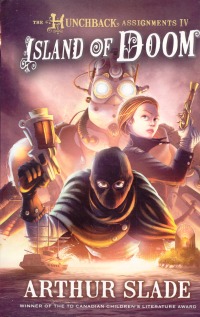| ________________
CM . . .
. Volume XVIIII Number 2. . . .September 14, 2012
excerpt:
Arthur Slade has taken elements from all over the classical and science-fiction literary map and knitted them together in this series of “Hunchback Assignment” novels. Firstly, of course, there is Modo, the hunchback who, in this final book, actually does establish a connection with Notre Dame cathedral (he was abandoned there as a baby), although Victor Hugo's "hero" certainly did not have Modo's amazing shape-changing abilities. In his natural shape, Modo is so ugly that he wears a mask: Hello, Phantom of the Opera! Then there is Mr Hyde, the mad scientist more akin to Dr. Moreau than Dr Jeckyll, who makes humanoid monsters from the bodies of the recently dead. However, he seems able to animate them only if he has access to some part of Modo's body -- his little finger cut off by Miss Hakkandottir in the previous book, for example. Mr Hyde's first creation is named Typhon, after the "father of all monsters" in Greek mythology who was created at the beginning of the world by Gaia and finally destroyed when Zeus threw Mount Etna on top of him. He was not a nice person; his namesake isn't either -- huge, ugly, and impervious to bullets and knives since one cannot kill what is already dead. All these pieces are tied into a story which is the sequel to three previous encounters/books in which the the Clockwork Guild (the baddies) attempt to destroy Britain and its Empire. The Permanent Association (the good guys), under the leadership of Mr Socrates, Modo's benefactor and adoptive father, and with the muscle power and peculiar abilities of Modo and Octavia, another adoptee this time from the London gutters, have defeated the Guild's previous attempts to destroy England, but without damaging its basic organization. After all, what does the loss of a large sea-going warship or a huge airship actually matter if the brains of the Guild -- the Guild Master -- remains at large? Spoiler alert: the good guys finally win, and the Trojan horse makes an appearance. All in all, it is a good science-fiction/fantasy blend, and a recommended read. Recommended. Mary Thomas, who has retired from working in Winnipeg school libraries, has enjoyed “The Hunchback Assignments” books very much as have the students in her school's MYRCA (Manitoba Young Readers’ Choice Award) club.
To comment
on this title or this review, send mail to cm@umanitoba.ca.
Copyright © the Manitoba Library Association. Reproduction for personal
use is permitted only if this copyright notice is maintained. Any
other reproduction is prohibited without permission.
NEXT REVIEW |
TABLE OF CONTENTS FOR THIS ISSUE
- September 14, 2012.
AUTHORS |
TITLES |
MEDIA REVIEWS |
PROFILES |
BACK ISSUES |
SEARCH |
CMARCHIVE |
HOME |
